Dr. Phil Zeltzman’s Blog
Ninja, my biggest surgical & ethical challenge in 2021
“I beg you for help.”
Such was the subject line of the email.
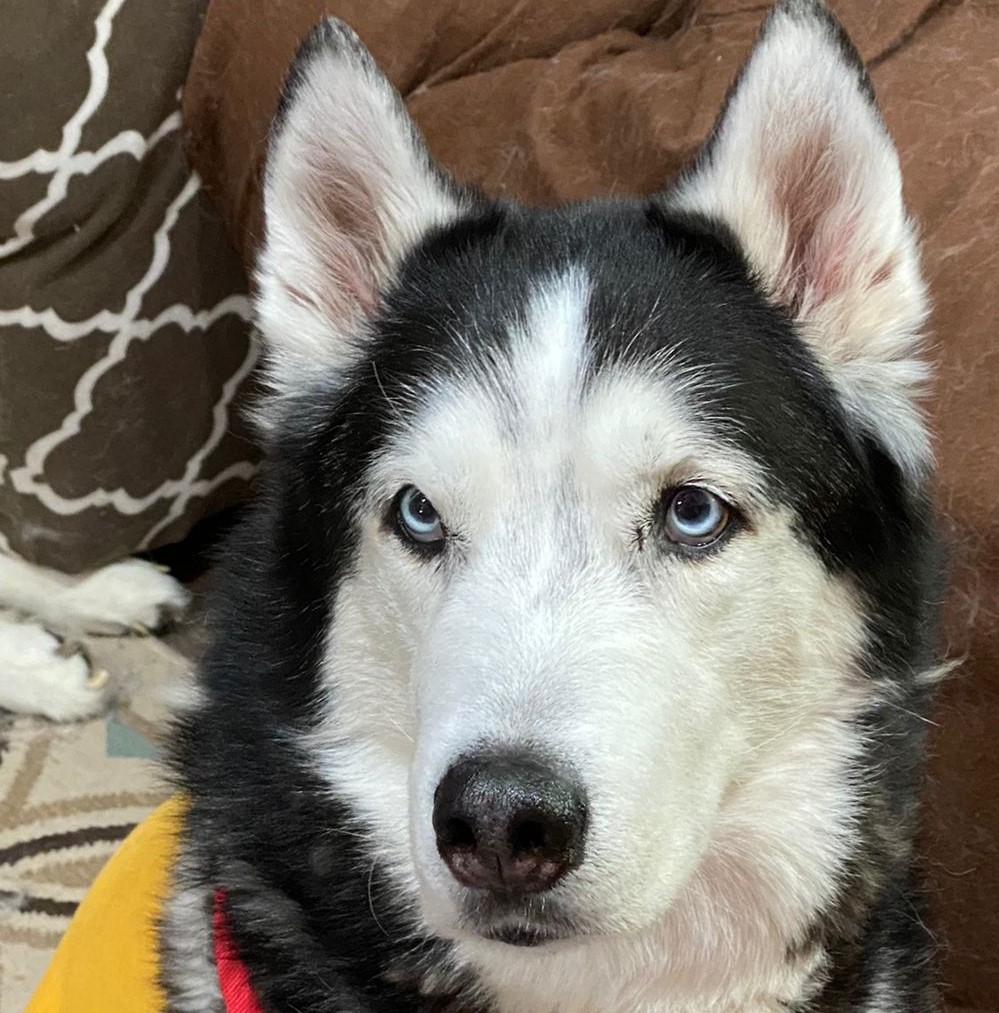
In the email, a pet owner explained:
“My dog Ninja, a 6 year old Siberian Husky, just had a CAT scan, then surgery to drain a cyst in his enlarged prostate” (17 cm long – about 7 inches).
“Because of the pressure on the colon and the bladder, Ninja couldn’t defecate or urinate!”
“His bladder has been so over-stretched, that it couldn’t contract and now Ninja still can’t urinate. A urinary catheter was placed temporarily… and the only option the surgeon gave us was euthanasia!”
“I don’t want to put him down. He is eating, drinking and (now) pooping. He acts normal but can’t pee. Please help me, I am very desperate.”
Desperate times call for desperate measures.
Ninja had a condition similar to unfortunate older gentlemen who struggle to pee because of an enlarged prostate. It is a frustrating & painful situation. But in a dog, it can be life-threatening.
There is a better solution than euthanasia. I suggested a surgery that involves placing a special tube in the bladder and allows draining the bladder on demand.
It’s certainly not for every pet owner, but Ninja’s owners were exactly the right people for the challenge: dedicated, attentive, and totally in tune with their dog. They had done their homework and found out about this option by reading my blog about Madeline, who had the same surgery for a different problem (a bladder tumor).
Chapter 1
Time was of the essence, so we quickly scheduled surgery at Brodheadvsille Vet Clinic.
Ninja had a “cystostomy” surgery, where a tube was placed to drain the bladder through an opening in the skin.
In addition, Ninja was neutered. After that necessary step, male hormones would decrease and cause the prostate to shrink. That would reduce the pressure on the urethra and allow Ninja to urinate.
Chapter 2
Everything went according to plan for about a month… until Ninja accidentally stepped on the tube.
The logical next step was to replace the life-saving drain. Unfortunately, preop bloodwork showed some concerning changes. Ninja’s immune system was attacking his own red blood cells (hemolytic anemia) and platelets (thrombocytopenia). This double condition is called Evans’ syndrome.
So we changed plans. Since it was too risky to perform surgery with such low numbers of red blood cells and platelets, we placed a traditional urinary catheter to allow Ninja to urinate.
We were able to do this thanks to the generosity of another practice owner near Allentown, PA.
The catheter had to be changed frequently to lower the risk of bladder infection (UTI).
His faithful owners would drain the bladder multiple times a day to allow it to stay small. Remember, the bladder was so over-stretched, that it couldn’t contract anymore…
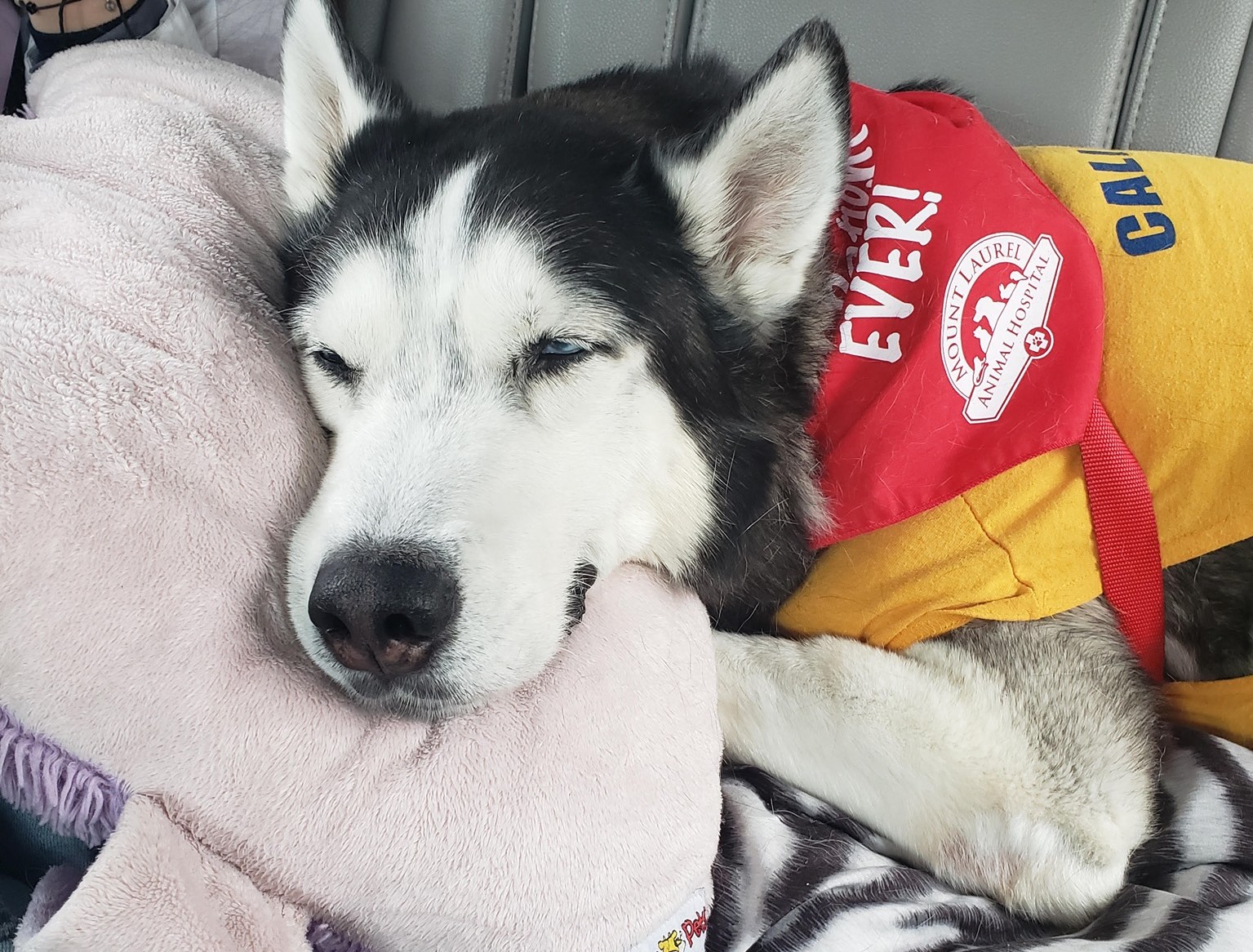
Chapter 3
At that point, Ninja was referred to a board-certified internist (a medicine specialist) to manage his Evans syndrome.
Meanwhile, Ninja still couldn’t pee!
To make matters worse, an ultrasound showed that the prostate now had an abscess. Again, euthanasia was recommended.
Again, his owner called me to see if there were any other options.
After reaching out to multiple specialists, we found one willing to help. My amazing nurse and I suggested a completely crazy plan:
. An ICU specialist at a specialty hospital in NJ accepted to let us use the key to our problem: a special transfusion with platelets to help with clotting.
. We would drain the abscess at another practice in NJ, and place a new cystostomy tube to allow Ninja to pee.
. We would recover Ninja under the supervision the ICU specialist.
Amazingly, Ninja’s owners decided to go with surgery, about 2 months after the first one.
The procedure was uneventful, and after 2 days in ICU, Ninja went home.
Then came weeks and months of amazing dedication from Ninja’s owners.
Long story short, Ninja progressively got better and stronger.
Then out of the blue, to everybody’s surprise, he started to pee on his own!
After agonizing over the right time to remove the tube, we eventually did, once we were convinced that Ninja was emptying his bladder on his own sufficiently to survive.
Now you understand why Ninja was such a technical and mostly ethical dilemma for me.
When should a surgeon stop helping?
When should a pet owner stop hoping?
When should a pet to cross the rainbow bridge?
Why did I choose Ninja’s story…
… over so many other amazing pet stories I was fortunate to play a part in in 2021?
Because of the number of people who played a role in Ninja’s survival.
In the middle of the COVID crisis, it was an absolutely astonishing display of generosity, love and care, by multiple vets and nurses.
Across half a dozen practices.
And across 2 States (PA & NJ).
(trust me, I gave you the short version!!!)
Everybody rallied behind Ninja, led by his loving owners.
And the result is one happy, playful, fluffy Husky, whose only wish is to be comfortable, to be able to pee, and to return his owners’ love.
Ninja’s owner created an amazing video summary.
It’s a story about the love of a family pet.
A story about the power of dedication.
A story about not taking no for an answer.
You can watch it here: https://vm.tiktok.com/ZMRatj6Co/
Fair warning: it’s a tiny bit emotional…
What’s the moral of the story?
1. Neutering early in life decreases or eliminates the chances of having prostate issues in male dogs. There are many other good reasons, which you can read about here:
/blog/top-10-reasons-to-neuter-your-pet/
2. You are your pet’s best advocate. If something makes no sense to you, don’t give up. Sadly, there is not a solution or a cure for every condition. But at least, you should explore your options.
Don’t take no for an answer. Get a second opinion.
This is exactly what Madeline’s and Ninja’s owners did. They didn’t take no for an answer, and they saved their dogs’ lives.
Phil Zeltzman, DVM, DACVS, CVJ, Fear Free Certified

Dr. Phil Zeltzman is a traveling veterinary surgeon in Pennsylvania & New Jersey. An award-winning author, he loves to share his adventures in practice along with information about vet medicine and surgery that can really help your pets. Dr. Zeltzman specializes in orthopedic, neurologic, cancer, and soft tissue surgeries for dogs, cats, and small exotics. By working with local family vets, he offers the best surgical care, safest anesthesia, and utmost pain management to all his patients. Sign up to get an email when he updates his blog, and follow him on Facebook, too!
How Madeline got a new lease on life
Madeline, a 7-year-old shepherd mix, had trouble urinating for about two months.
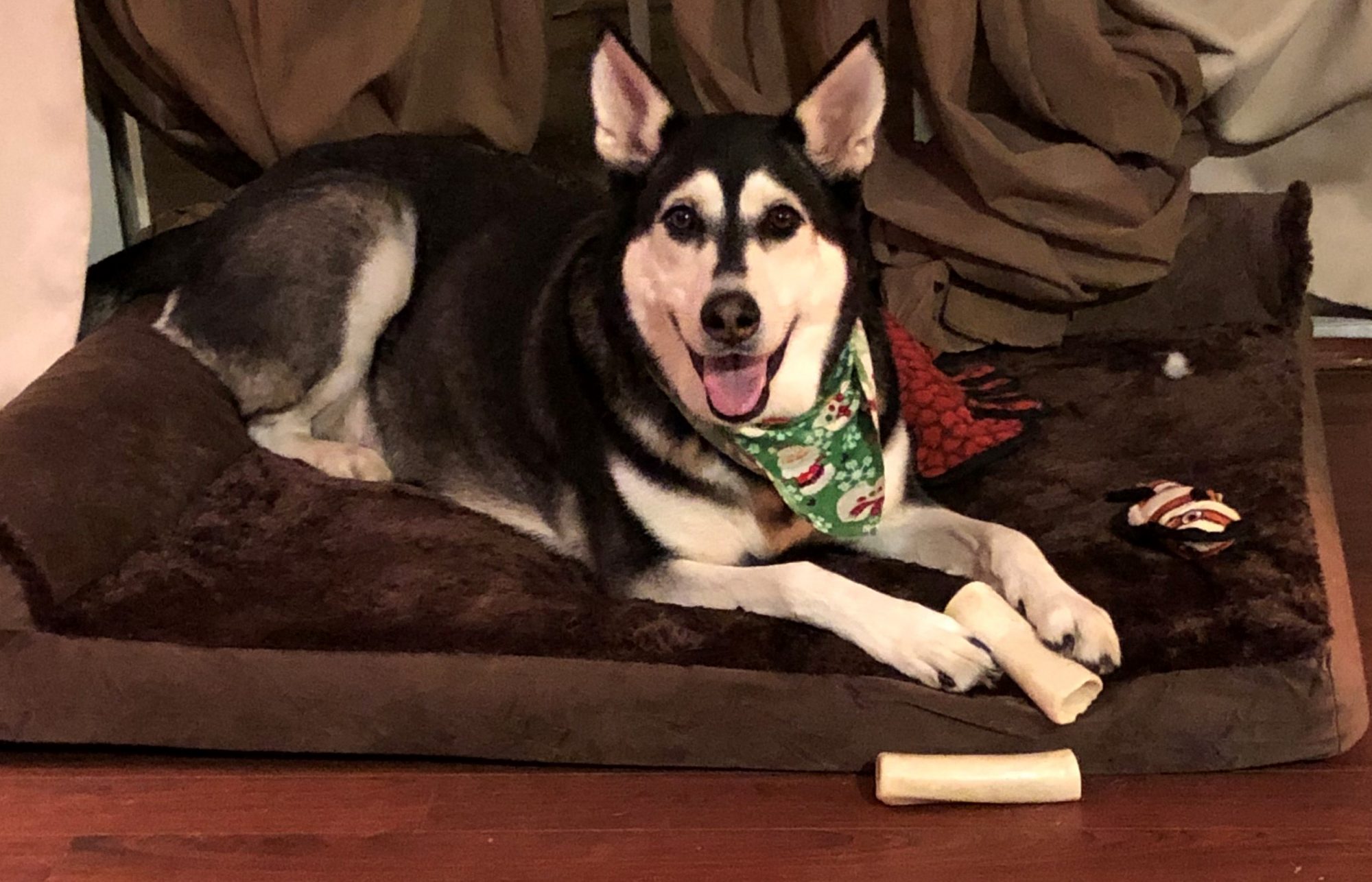
(You can tell from her picture that she’s not at all a spoiled pup!)
Fair warning: this is an unusually long blog. It’s longer than a tweet. If you read it until the end, you will learn several valuable lessons that could save your pet’s life one day. So please hang in there and read along. It’s actually a quick read!
Madeline would strain to urinate, with frequent attempts, and accidents in the house. There was no blood in the urine, which made it less likely to be a bladder infection.
X-rays didn’t show anything unusual, including bladder stones.
After two months of trying various treatments (antibiotics, steroids etc) that didn’t make any difference, Madeline’s owner got rather frustrated and went elsewhere to get an ultrasound. And that was the key decision: the ultrasound showed a mass in her bladder. Rather than being in an area where it’s easy to remove (eg the front of the bladder), it was located in the very back, at the junction of the bladder and the urethra (the tube between the bladder and the outside world). This area is called the trigone. It’s the muscle that allows a dog to be continent, ie the opposite of incontinent. This made removing the mass risky.
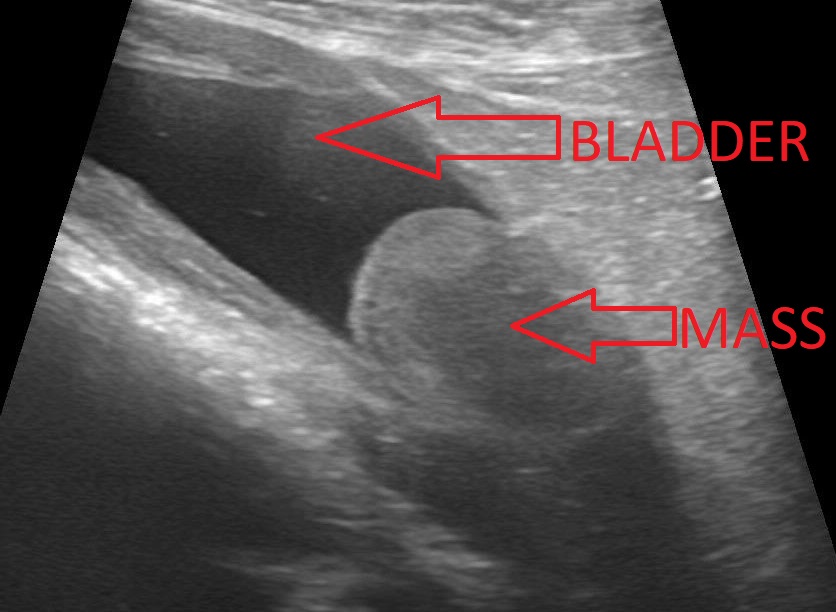
Depending on its position, the mass would randomly block the urethra, making it impossible for Madeline to urinate. Not only is this incredibly uncomfortable, it can lead to all kinds of complications including severe kidney damage.
Madeline’s owners went to several family vets and specialists to find a solution. They were told that the mass could not be removed or it would cause urinary incontinence. That it was in multiple locations in the bladder. That it was most likely cancer. And it was most likely a transitional cell carcinoma.
The only treatment suggested was radiation therapy – for $11,000. They were told that it may cause increased irritation of the bladder, which would lead to incontinence. “So the treatment could do more harm than good” explained Madeline’s owner.
She added: “We felt hopeless. Neither of us could focus on work. Every day, we would wake up not knowing if this was the day that our dog would not be able to urinate and we would have to put her down. I felt like the vets gave our dog a death sentence with no answers and no option for her to have any help whatsoever. This did not seem right to me. It did not seem ethical. We asked them desperately what they recommended and they told us if there is one thing that they could recommend, “it is not to get surgery.” They did recommend that we get her kidneys checked. Her kidneys were slightly enlarged, therefore she has no more than two weeks to live. We needed to monitor her closely to see when things got worse because then we would know when to put her down.”
The most often recommended palliative treatment for transitional cell carcinoma is a drug called piroxicam. It’s an anti-inflammatory drug, which side-effects include stomach ulcers.
So that’s what was prescribed for Madeline. Nothing else.
It is very tricky for me to write what follows, out of respect for the colleagues who were in charge of Madeline. But when solutions exist, I firmly believe that they should be offered to a loving, motivated pet owner. Then it’s their decision to accept or decline the treatment plan.
Madeline’s owner found me through my website, and they reached out for help. I had a few important concerns:
. Everybody was convinced this mass was cancerous, but there was no proof.
. No biopsy was suggested. The whole treatment plan (piroxicam) was founded on an assumption: that just because the most common bladder is transitional cell carcinoma, then that’s what Madeline had.
. And my most pressing concern: no immediate solution was offered to help her empty her bladder, which can absolutely lead to a life-threatening situation.
Madeline’s owner comments: “She went through an extended period of time being unable to urinate at all. No vet, emergency vet or specialist anywhere around us would give her immediate relief through a urinary catheter. I called Dr. Zeltzman in a panic and he immediately set us up with a clinic that would do the procedure. Luckily, she was able to urinate shortly after this and this was no longer an imminent need.”
. Surgery was completely eliminated as a solution by several specialists, including a surgeon.
So Madeline’s owners and I had a heart-to-heart discussion. After reviewing her medical record and ultrasound report, I suggested a 2-step surgery:
Part 1. Remove as much of the tumor as possible.
Yes, it was probable that we wouldn’t get it all.
Yes, it was likely that the tumor would regrow over time.
Yes, cancer was all over the bladder according to the ultrasound.
Yes, there was a risk of urinary incontinence.
But how exactly was Madeline supposed to empty her bladder with this mass blocking her urine? Trying to remove part of it would also allow sending a biopsy to the lab to get an actual diagnosis.
In addition, we’d know if piroxicam is the correct treatment.
Part 2. Then, we could offer my top-secret weapon: a solution to drain the bladder, short-term as well as short-term.
Of course, I’m joking. There is nothing secret about this solution. It’s in every surgery book.
I insisted several times that my solution “is not for everybody.” I explained that there were possible complications, such as repeated bladder infections. After several conversations, Madeline’s owners took a giant leap of faith. They went against the advice of multiple other vets, including specialists. And they asked me to put this plan into action.
WARNING – the next picture is graphic.
Prior to anesthesia, Madeline’s blood work was checked again to make sure her kidneys were functioning normally and there was no secondary issue caused by her urinary blockage. Everything came back normal and she was prepped for surgery.
Again, the 1st step was to remove the tumor. It was a little bit bigger than a dime. Small, but potentially deadly. It clearly blocked the entire urethra. It was removed as gently as possible from inside the bladder/urethra junction.
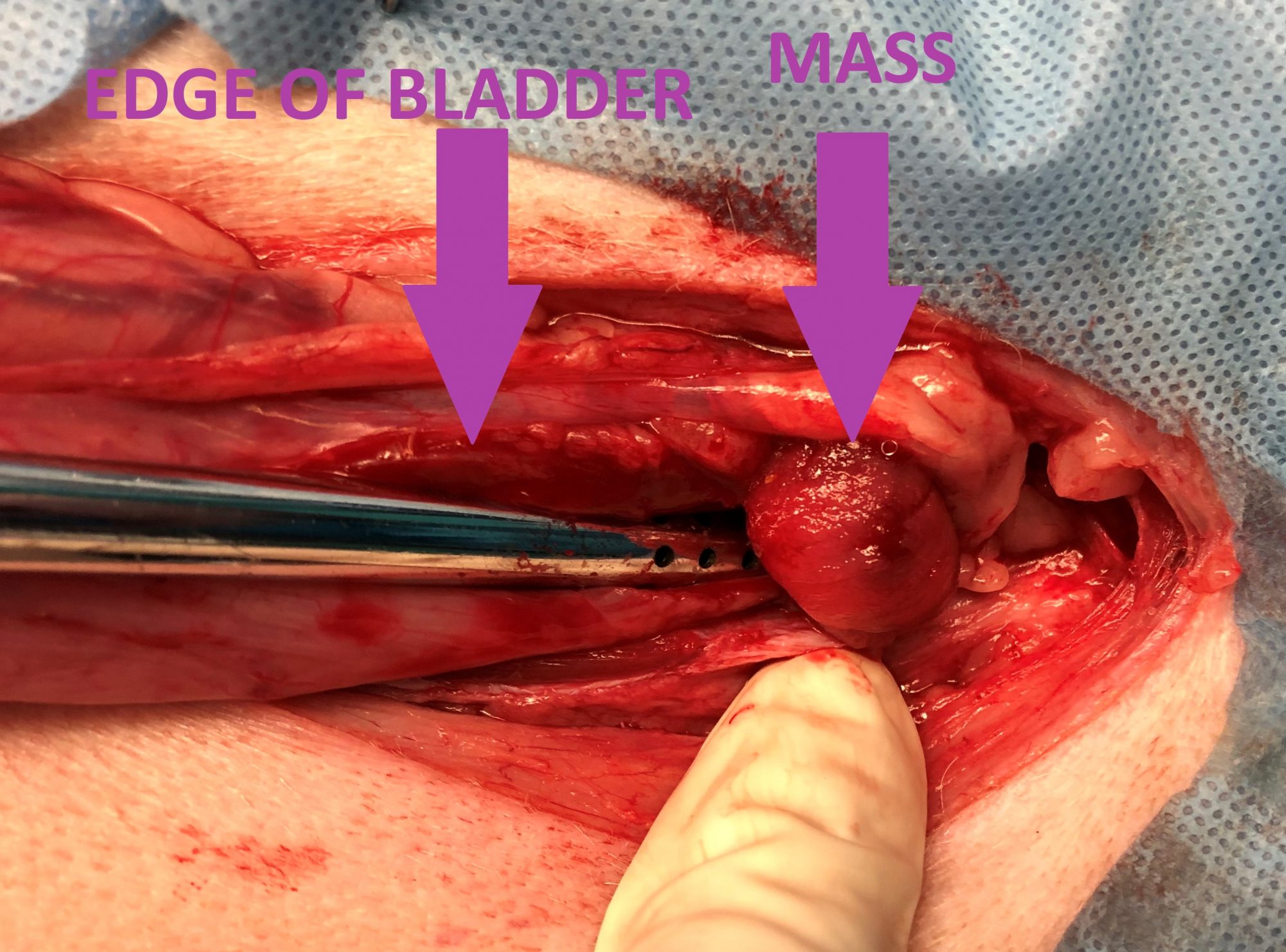
The rest of the bladder felt normal to the touch and looked normal. There were no obvious signs of spreading throughout the bladder.
Next, came my no-so-secret weapon: it’s a special tube called a cystostomy tube. This is a soft tube that is placed in the bladder and comes out of a small incision in the belly. The tube has a special valve attached to it to control the flow of urine, allowing the owners to empty the bladder as needed. The tube can remain in place in the short-term. In Madeline’s case, it may very well stay in for life.
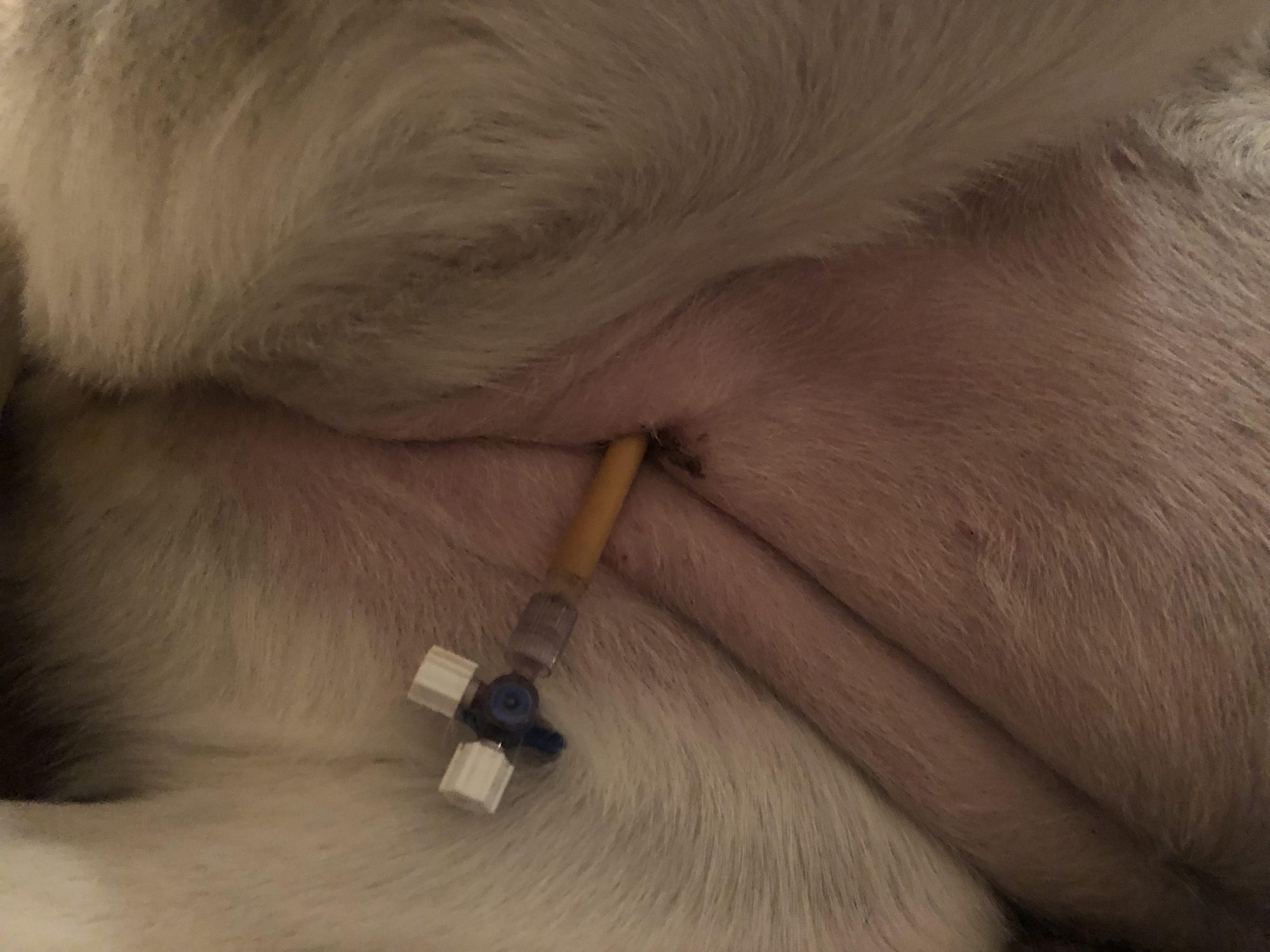
Surgery went very well and Madeline recovered smoothly. She went home after her owners were showed how to care for the cystostomy tube.
No big surprise, she was able to urinate on her own shortly following surgery, which was a relief – literally! Regardless, I instructed her owners to use the tube once a day to get comfortable with it. This way, they would be proficient at using it, the day it might be the only option Madeline has to empty her bladder…
About 1 week after surgery, the biopsy report came back. Guess what? Madeline’s tumor was not transitional cell carcinoma! Sadly, it was cancer. It is a rare tumor of the muscle of the bladder called leio-myo-sarcoma. Which doesn’t responds to piroxicam.
Amazingly, the pathologist said that we got it all – although with “very narrow margins”, which means that it is likely to come back.
A week after surgery, Madeline was doing “fantastic”. She was urinating on her own normally. Her owners “could not be happier.” They were taking excellent care of her cystostomy tube and emptying the bladder once daily as instructed.
Two weeks after surgery, the staples were removed. Her owner commented: “We’re doing great! Never happier! Madeline is doing fantastic! It is almost like she knows that her life was saved and she is showering us in kisses to show us her appreciation. She has completely adapted to wearing a cone and even carries her ball around in her cone! The incision site looks clean and dry. We’re so thrilled with how she has progressed so far. We cannot thank you enough for all you have done.”
I guess the giant leap of faith was the right decision…
Please understand that my point in sharing Madeline’s story is not to brag. My goal is not to show that I am smarter than anybody else.
My goal however, is to remind loving pet owners of a few important, simple facts (which long-time readers have read about many times before in this blog):
. Don’t make assumption when it comes to a cancer diagnosis. Lives are at stake here. Demand proof of the diagnosis – when possible. I’ve treated many “cancer” patients who never had cancer at all…
. Trust your gut. If you are not comfortable with a practice, or a vet, or a treatment plan, then get a 2nd or a 3rd opinion. Within reason of course.
. Just because you’re not a vet doesn’t mean that you can’t use your own logic. If there is a blockage, are there viable solutions to relieve it? If cancer is suspected, can we prove it? Can we find out which type before a treatment is recommended?
Madeline’s owners unknowingly did all of that. They weren’t satisfied with the lack of options to help their dog. They thought that there might be a better solution than a death sentence. Fortunately for Madeline, they were right.
We don’t know how long Madeline will be around. Bladder cancer is a serious diagnosis. To me, and to her owners, it’s not so much a matter of quantity of life (ie survival), it’s mostly a matter of quality of life. Being able to urinate freely is one of the mandatory requirements.
Madeline owner concludes: “We couldn’t be more grateful for what Dr. Zeltzman has done. Although we do know that she still has cancer, Dr. Zeltzman gave us more time with our baby. Most importantly, he gave us options while giving her pain relief.“
Phil Zeltzman, DVM, DACVS, CVJ, Fear Free Certified

Dr. Phil Zeltzman is a traveling veterinary surgeon in Pennsylvania & New Jersey. An award-winning author, he loves to share his adventures in practice along with information about vet medicine and surgery that can really help your pets. Dr. Zeltzman specializes in orthopedic, neurologic, cancer, and soft tissue surgeries for dogs, cats, and small exotics. By working with local family vets, he offers the best surgical care, safest anesthesia, and utmost pain management to all his patients. Sign up to get an email when he updates his blog, and follow him on Facebook, too!

